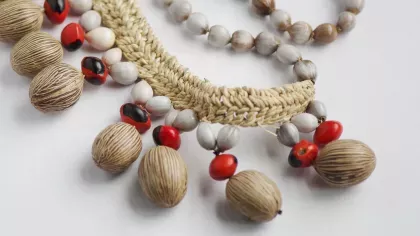History and curation of economic botany collections
Researching collections of plant raw materials and artefacts that shed light on history, ethnobotany and indigenous knowledge.

The Economic Botany Collection
The world’s first Museum of Economic Botany was established at Kew in 1847, predating the founding of the Herbarium by six years. William Hooker saw the Museum both as a resource for public education, and as the means by which modern botany could be applied to the manufacturing industry, where plant raw materials were supplied by producers. Within a few years similar museums had sprung up worldwide, though many went into decline in the 1950s, when natural products appeared old-fashioned. The Kew Museum (now Economic Botany Collection) is one of the few to have carried on growing. Its size (nearly 100,000 specimens), diversity, and rich documentation make it an excellent resource for exploring the history of economic botany, both at Kew and worldwide.
Research
Recent work includes Caroline Cornish's PhD thesis on the history of the Kew Museums and the subsequent Economic Botany Collection, which has given us a far more nuanced understanding of the links between the museum and the changing context of empire and science. During Caroline's research, it became clear that the Kew Museums stimulated many such collections all over the world, and we are currently preparing a project proposal to investigate this further.
Two research projects currently in development concern individual explorers: Richard Spruce, who sent to Kew about 300 ethnographic artefacts from the Rio Negro in the Amazon. Working with William Milliken (Kew) and Luciana Martins (Birkbeck) we aim to better document the Kew collections, and re-establish contact with the source communities. David Goyder (Kew) is starting a similar project on the collections from David Livingstone's Zambezi Expedition.
Everard im Thurn, British botanist and administrator in Guyana, was the subject of a PhD thesis by Sara Albuquerque.
Alongside these major projects, it has been possible to develop a series of smaller studies, for example on Kew's links with Mexico and Japan (published), Jamaica (in press) and Australia (in progress).
Kew has recently joined UCL's Assembling Alternative Futures for Heritage project as a partner, and we look forward to the new perspectives this will bring to collections practice here.
Curation
We have learnt a lot about how to manage the diverse and highly fragile specimens in the Economic Botany Collection, in a way that preserves them for the future, both as a natural history and a cultural resource. We share our experience through teaching, publications, and active participation in the Biocultural Collections group.
Objectives
- Understand the development of the former Kew Museums (now Economic Botany Collection) in the context of the history of Kew (and thus of the British Empire).
- Undertake detailed case studies of the acquisition of objects and indigenous knowledge, based on integrated research into Kew’s varied collections (manuscript, art, printed, herbarium, as well as economic botany).
- Investigate Kew’s role in the formation of botanical museums elsewhere, and the distribution of more than 75,000 specimens to other museums.
- Share Kew's experience of curating and repurposing historic botanical collections with other museums.
Project Leader
- A major project starting in January 2017: The Mobile Museum: economic botany in circulation, funded by the Arts & Humanities Research Council. This is a collaboration between Mark Nesbitt at Kew and Felix Driver and Caroline Cornish at Royal Holloway, University of London. It will investigate Kew’s role in distributing more than 75,000 ethnobotanical specimens to other museums in the 19th century, and retrace connections with ‘lost’ objects.
- Enhancement of Economic Botany Collection database with detailed provenance data and more specimen images.
- Case studies of groups of specimens through collaboration with university departments. A small sample of work so far has included World’s Fairs, the model indigo factory, ancient Egyptian specimens, Japanese lacquer, Chinese rice paper, rubber, Eucalyptus oils, the voyage of HMS Galatea, and handmade Japanese papers (washi).
- Increased visibility of Kew’s economic botany heritage in public interpretation and publications.
- Two major grant proposals for collaborative projects have been submitted on
- the Amazonian collections of Richard Spruce and;
- on the history of Cinchona.
UK
- Camberwell College of Arts – Conservation programme
- Royal College of Art – History of Design
- Royal Holloway, University of London – Historical Geography
- Institute of Archaeology, University College London
- Institute of Archaeology, University College London – Museum Studies
- Institute of Archaeology, University College London – Assembling Alternative Futures for Heritage
International
- Natural History Museum, Copenhagen - Rønsted Lab
- Arts & Humanities Research Council
- Royal Holloway, University of London
- SYNTHESYS
Nesbitt, M. & Cornish, C. (2016)
Seeds of industry and empire: economic botany collections between nature and culture
Journal of Museum Ethnography 29: 53-70
Salick, J., Konchar, K. & Nesbitt, M. (2014)
Curating Biocultural Collections: a Handbook
Kew: Royal Botanic Gardens, Kew, 406pp
Cornish, C. & Nesbitt, M. (2014)
Chapter 20. Historical perspectives on western ethnobotanical collections, pp. 271-93. In: Curating Biocultural Collections: a Handbook. Edited by J. Salick, K. Konchar, and M. Nesbitt
Kew: Royal Botanic Gardens, Kew
Cornish, C., Gasson, P. & Nesbitt, M. (2014)
The wood collection (xylarium) of the Royal Botanic Gardens, Kew
IAWA Journal 35: 85-104
Cornish, C. (2013)
Curating Science in an Age of Empire: Kew's Museum of Economic Botany
PhD thesis, Department of Geography, Royal Holloway, University of London
